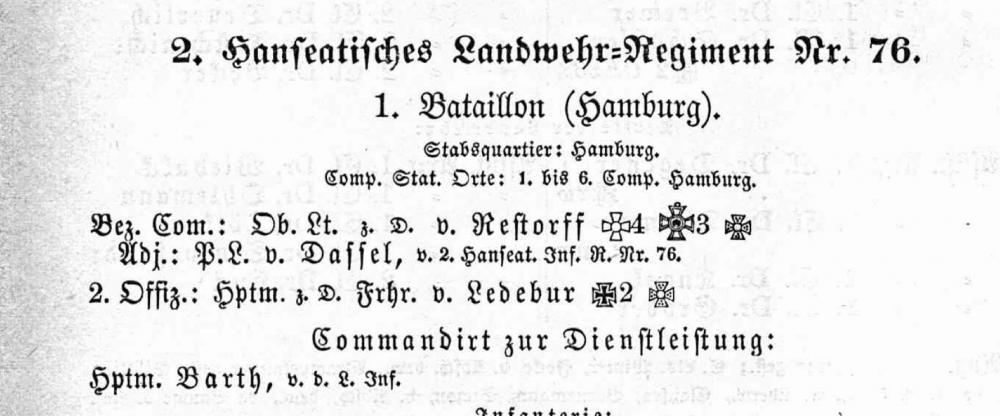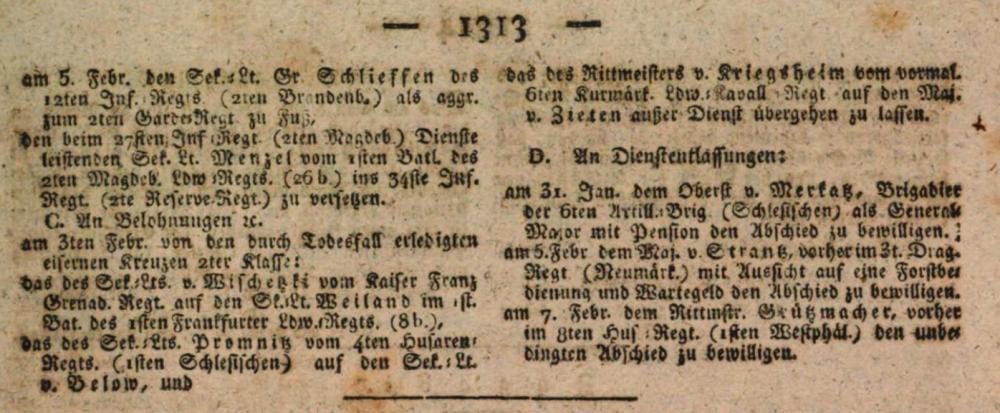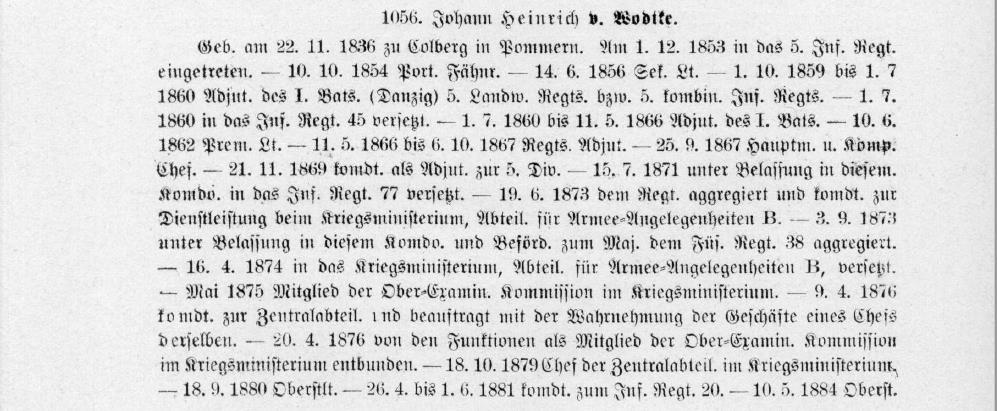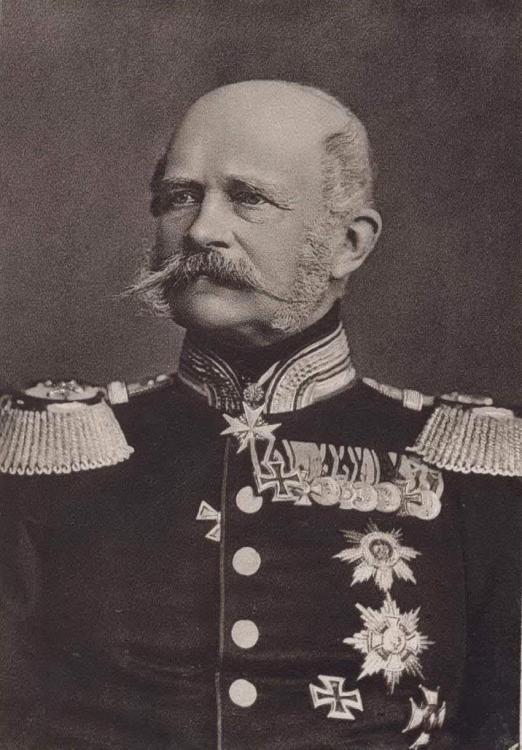-
Posts
2,234 -
Joined
-
Last visited
-
Days Won
55
Content Type
Profiles
Forums
Blogs
Gallery
Events
Store
Everything posted by Glenn J
-
Hello, Hans Dedo Freiherr von Milkau, born 1858 at Skassa near Großenhain. Entered the Saxon army in 1874 and was promoted to Portepee-Fägnrich in 1. Husaren-Regiment Nr. 18 on 10. April 1876. Sekonde-Lieutenant: 21.9. 77 E Premier-Lieutenant: 26.10.83 A Rittmeister: 20.5.90 Major: 28.6.99 E 1899: Adjutant of 3. Division Nr. 22 1902: Major on the staff of 1. Husaren-Regiment Nr. 18 23.4.1904: Commander of 1. Ulanen-Regiment Nr. 17 Oberstleutnant: 15.4.04 A Oberst: 25.3.07 D 14.7.09: Officer of the Army 20.10.09: Provisional commander of 2. Kavallerie-Brigade Nr. 24 24.9.10: Retired with character of Generalmajor Died 24.12.1913 Regards Glenn
-

A question for Glenn ( and other gnomes)
Glenn J replied to Ulsterman's topic in Germany: All Eras: The Iron Cross
Geoff, as can be seen from this extract from the 19 February 1820 edition of the "Militair-Wochenblatt", awards of deceased holders of the Iron Cross were further awarded to deserving recipients. So for example as shown here, the award of the deceased Sek.-Lt. von Wischetzki went to Sek.-Lt. Weiland, that of Sek.-Lt. Promnitz to Sek.-Lt.von Below and that of Rittmeister von Kriegsheim to Major von Zieten. Regards Glenn -
The description of this individual has been troubling me for some time. I am at a loss to understand how a Paymaster candidate (who would hold the rank of an active NCO) would wear the shoulder boards of an official of the pay groups A8 through A10. I have been through all the editions of the Allgemeine Heeresmitteilungen which described the insignia of rank and their subsequent alterations and I can find no reference to a candidate wearing this combination of insignia. As described on page 38 of the AHM 1935 (Rw. Minister, 20.3.35 V5 IIIa), the insignia as worn by solders who were appointed as paymaster candidates (Zahlmeisteranwärter) wore a speciality badge on the lower right sleeve with the letter V. (See also Angolia/Schlicht volume 2 page 26). An order of 21 January 1942 (Ob.d.H., 21.1.42 - 25 g 14 - VA/Ag VI/V 1/Gr I (A) stated that the Zahlmeisteranwärter now wore the uniform of an official at the entry point for that career with the rank insignia of a Zahlmeister. To differentiate the candidate between those officials already holding the rank of either a substantive or non-substantive Zahlmeister, the candidate wore 1 cm wide lace strip across the base of the shoulder board in green. Is this chap then perhaps an official with the equivalence of senior NCO rank who has just "upgraded" his collar patches as a personal preference? If such an order as alluded to in the thread: "One is a senior NCO / Paymaster candidate. When he finished his probationary candidacy he'll upgrade the boards. Note, also that senior NCO's who were officer candidates were authorized to wear Officers type collar tabs and chin cords on their visor caps.", exists, I would certainly be most grateful for details. Regards Glenn
-
Hi Graham, I don't think he could be General Barger. The General was not promoted to Generalmajor until 24 December 1935, some two and a half years after the reintroduction of the former k.u.k. style uniform. Eduard Barger is pictured here still as a colonel in the newly reintroduced uniform whereas the General officer at the beginning of this thread is wearing the older pattern Bundesheer uniform. Regards Glenn
-
Charles, Freiherr von Leonrod was listed as an "Offizier à la suite der Armee" with the uniform of a Flügel-Adjutant. He was a senior official at the court of the Bavarian King. His final rank was that of an Oberst (11.10.14). He was appointed as a Flügeladjutant to King Ludwig on 23 December 1912, having previously been the then Prince Ludwig's personal adjutant. He retired from active service on 12 June 1913 and was appointed à la suite der Armee with his previous uniform. Regards Glenn
-
Charles, Most likely. Graf Castell-Castell was promoted to Generalmajor on 28 May 1918, Patent of 28.5.18 (4) but was not elevated to an appointment as General à la suite or General-Adjutant and retired still in the appointment of a Flügel-Adjutant with Major-General's rank on 28 December 1918. I am not aware of any other individuals in that rank serving as Flügeladjutanten at this period. Regards Glenn
-
Chris, well officially, Offizier-Aspiranten should not wear an officers’ helmet. They usually held the rank of Vizefeldwebel /Vizewachmeister d.R. As such they would usually wear an issue helmet with the officer pattern cockade. Of course, during wartime, I am sure that some guys would have “upgraded” their helmets contrary to regulations. Regards Glenn
-
Claudio, he does not appear in the officer/official lists of either the k.u.k. Army or k.k. Kandwehr. I am assuming he is a Landsturm military official. That does seem to be a rank "Rosette" on the collar as worn by officials as opposed to a star worn by officers. Regards Glenn
-
Does he have a name? Regards Glenn
-
GD, I have been researching the Prussian army for many years and as Andy rightly said, there sometimes are not the answers in black and white that we desire. However, I will offer an opinion. The first two promotions of the the Prince of Prussia and Prince Carl were "one offs", that is promotions of two individuals who were Hohenzollern princes and therefore according to past practice were not promoted to actual GFM rank but accorded the dignity and seniority as such with a different title; Generaloberst and General-Feldzeugmeister respectively. Following King Wilhelm's accession to the throne and the successful course of the Franco-German war, he changed the practice used hitherto and promoted two Hohenzollern princes (both army commanders) to the rank of GFM. It will be seen that all the other wartime and immediate post war promotions to GFM were of former army commanders, the chief of staff and the war minister: Moltke, Roon, Manteuffel, Herwarth (1866) and Steinmetz. With the the creation of army inspectorates following the creation of the German Empire, promotions of senior generals to these posts at a time when the nation was no longer at war allowed for the promotion to Generaloberst but still ranking as a GFM. Additionally, the corps commander of the Guards Corps, Prince August was so promoted. As time went on, the fine distinctions were blurred and as Andy alludes, Kaiser Wilhelm was probably more generous with his promotion policy (as indeed he was with his awards policy) and this accounts for Haeseler, Bock und Polack and Goltz's peacetime promotions to GFM. Certainly until 1900 one can consider the holders of the ranks of Generalfeldmarschall, Generaloberst der Infanterie, Generaloberst der Kavallerie and General-Feldzeugmeister as holding the rank of a Field Marshal and they were consequently listed together in order of seniority in the army list. Promotion policy and politics is a difficult minefield to navigate in the Prussian army and this is exacerbated by the wartime destruction of pretty much all the original primary documentation. Nothing is clear cut; we have a peacetime corps commander - Graf Haeseler as a GFM and wartime army group commanders such as von Below and von Gallwitz as a General der Infanterie and Artillerie respectively! Regards Glenn
-
There is an interesting section in the book by Reinhard Stumpf - "Die Wehrmacht Elite" which covers in some detail the development of the rank of Generaloberst. He refers to the case of the future Kaiser WIlhelm I who was promoted to Generaloberst by his brother, King Friedrich Wilhelm IV. for his army command in the 1849 Baden campaign. He refers in this case to an " unwritten rule, lost in the depths of time, that Hohenzollern princes could not attain the rank of Field Marshal.This would also have applied in the case of Prince Carl's promotion to Generalfeldzeugmeister. In any case, titles aside, at this time the rank of Generaloberst ranked equally with the Generalfeldmarschall. This unwritten law was broken with the promotion of the Crown Prince and Prince Friedrich Karl to Generalfeldmarschall in October 1870. Below is a portrait of Generaloberst (2 Sep 73) Prinz August von Württemberg, commanding the Guards Corps. One can ascertain at least two of his three stars plus crossed batons. I heartily concur with Andy's last couple of sentences! Regards Glenn







